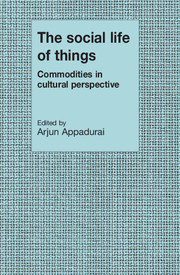Book contents
- Frontmatter
- Contents
- Contributors
- Foreword
- Preface
- Part I Toward an anthropology of thing
- Part II Exchange, consumption, and display
- 3 Two kinds of value in the Eastern Solomon Islands
- 4 Newcomers to the world of goods: consumption among the Muria Gonds
- Part III Prestige, commemoration, and value
- Part IV Production regimes and the sociology of demand
- Part V Historical transformations and commodity codes
- Index
3 - Two kinds of value in the Eastern Solomon Islands
Published online by Cambridge University Press: 05 June 2014
- Frontmatter
- Contents
- Contributors
- Foreword
- Preface
- Part I Toward an anthropology of thing
- Part II Exchange, consumption, and display
- 3 Two kinds of value in the Eastern Solomon Islands
- 4 Newcomers to the world of goods: consumption among the Muria Gonds
- Part III Prestige, commemoration, and value
- Part IV Production regimes and the sociology of demand
- Part V Historical transformations and commodity codes
- Index
Summary
It has been many years since Malinowski made the useful distinction between ordinary commodities, which were exchanged in conventional markets, and valuables, which could be exchanged only for one another and in restricted, ritualized contexts. This distinction between general and restricted exchangeability has been one of the main topics (and source of contention) in the comparative study of economic systems. Here, I will describe how labor and materials are combined to produce durables that cannot be further exchanged. These are objects that are beyond the potential of exchangeability and therefore outside the category of commodities.
The geographic area I will be discussing is part of the Eastern Solomon Islands in the southwestern Pacific, comprising the eastern half of San Cristobal Island and the two small, off-lying islands of Santa Ana and Santa Catalina. All the communities in this area speak dialects of a language originally designated as Kahua; all have local cultures that are quite similar and are different from cultures and languages of western San Cristobal and the Santa Cruz Islands to the east. My focus will be the small island of Santa Catalina, or Aoriki, because that is where I did the most intensive fieldwork (1965–66) and where the precolonial culture was best preserved.
There are many occasions and events in these societies at which the exchange and consumption of key commodities are crucial to the maintenance and alteration of social relations, but those that command the greatest attention and that, at appropriate times, represent the ultimate social effort are the three commemorative celebrations, or -murina, for important deceased relatives.
- Type
- Chapter
- Information
- The Social Life of ThingsCommodities in Cultural Perspective, pp. 95 - 109Publisher: Cambridge University PressPrint publication year: 1986
- 8
- Cited by



